Berkeley SOSIP
Produced by the
Preservation Institute
My Focus
Replacing the State Health Dept Building
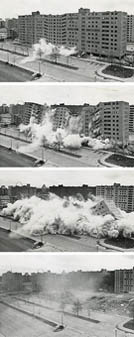
For me, there is a strong symbolic resonance to replacing a modernist highrise with a fine-grained urban fabric of walkable streets. It is a rejection of modernist urbanism that reminds me of the demolition of the Pruitt-Igoe housing project, shown above. But it is even better, because the modernist urbanism is being replaced by an urban fabric created in a piecemeal way, like traditional urban fabrics.
My Focus
In my opinion, the most exciting thing about the SOSIP is the opportunity to replace a very destructive piece of modernist urbanism with a network of pedestrian friendly streets. We can convert an area that is now ugly and unsafe into a network of pedestrian-friendly streets going all the way from Hearst Ave. to Center St., creating a long stretch of streets with extra-wide sidewalks and cafe seating.
This is possible because UC is demolishing the State Health Dept. Building, a highrise surrounded by a parking lot that represents everything wrong with modernist urbanism.
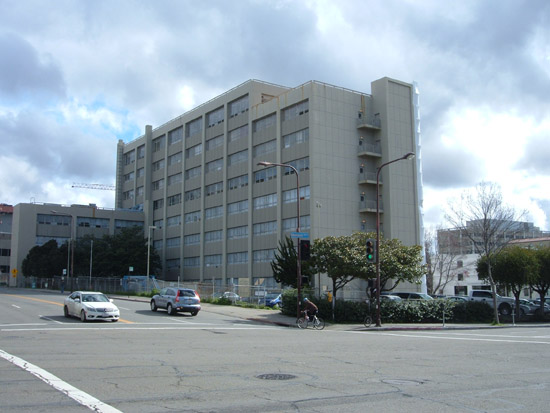
Below is the view of the State Health Building from Walnut St. (to its north). Hearst Ave., in the foreground, was widened to four lanes at about the same time this building was built. The SOSIP proposes restriping Hearst so it has two car lanes, which would make the street more pedestrian friendly and also let us add two bike lanes connecting the city’s bike lane system to the UC campus.
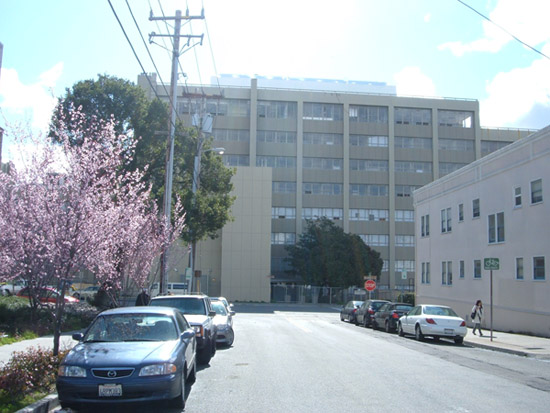
One block of Walnut St. was removed to assemble the site for the State Health Building, and you can see in the picture above that it breaks the continuity of the street. After it is demolished, UC has agreed to add a pedestrian street on the site, connecting the stretch of Walnut St. to its north with the block of Walnut St. to its south. UC will build the Helios Center for clean energy research to the east (left in the picture above) of this pedestrian street, and will build a public health campus to its west.
After walking along this pedestrian street, you will be on Berkeley Way, looking down Walnut St. to its end at University Ave. My proposals to widen the sidewalk of Berkeley Way and to improve Walnut St. would make this a more attactive block.
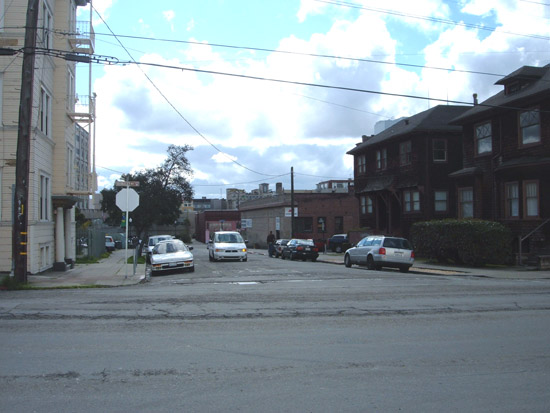
Then you will be able to walk down Walnut St. to University Ave. This part of University Ave is currently rather bleak, even though it is right next to the UC Campus, and has some parking lots that need to be filled in with new development. The SOSIP proposes narrowing University Ave. it to two traffic lanes instead of four on this stretch east of University Ave., so we can widen the sidewalk and make it more pedestrian friendly.
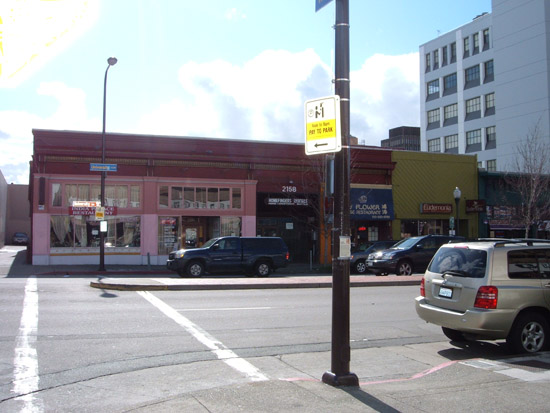
There is a small parking lot on one corner of University and Walnut St., and there is a small food stand there with outdoor seating that attracts many customers - a sign of how much potential this stretch of University Ave has for adding restaurants with outdoor seating after its sidewalk is widened. This parking lot, the one story building next to it, and the small parking lot beyond should be replaced with a building that more is in scale with downtown, perhaps a story of shopping with four stories of housing above.
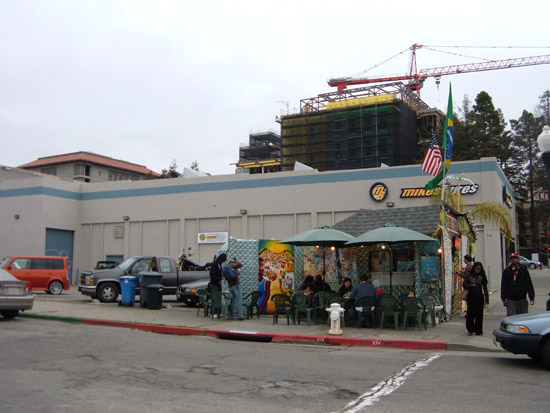
After University Ave. has its sidewalks widened and its roadway narrowed, it will be easy to cross University to get to the east branch of Shattuck Ave.
Currently, this branch of Shattuck carries aggressive through traffic, but the SOSIP allows us to make the west branch carry all the through traffic, and to restrict the east branch to local traffic only. As you can see in the picture below, the through traffic on the east branch makes this intersection very pedestrian-hostile. With the east branch restricted to local traffic, this will become a pleasant intersection that is easy to cross.
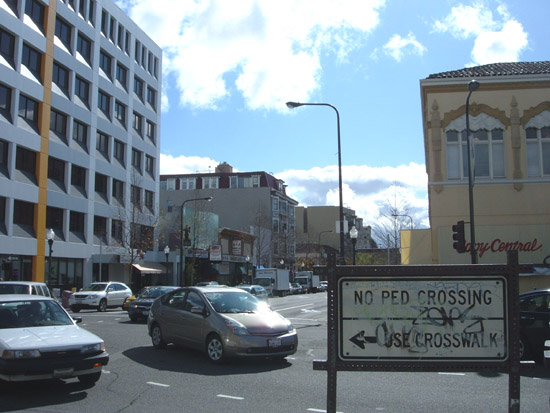
With with the east branch of Shattuck restricted to local traffic, it will be possible to widen the sidewalks of the east branch. This street is already full of restaurants that could easily add sidewalk seating, making it a very appealing street.
If you walk the two blocks of the east branch of Shattuck, you get to Center St., which already has a widened sidewalk with cafe seating on its south side (right in the picture below). There are plans to build an art museum and convention center/hotel on its north side. The SOSIP allows us to make this block of Center St. pedestrian only and to day-light a creek that runs under it.
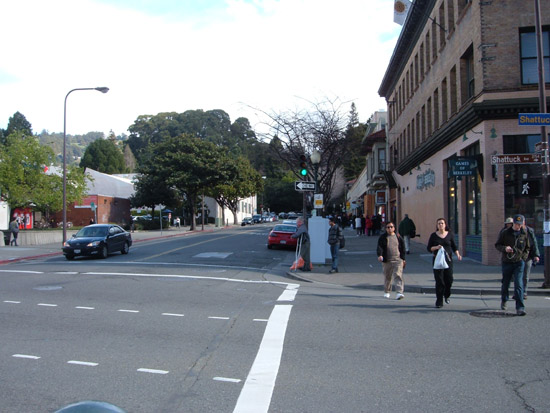
It will change the character of downtown completely to have a network of walkable streets with wide sidewalks leading all the way from Center St. to the Public Health Building site. A pedestrian street with a restored creek on Center St. would be a focus of downtown. It is very important to create an entire network of pedestrian-friendly streets connecting it with the part of downtown to its north, in order to draw people from the new Public Health campus and from the UC campus to the center of downtown.
The change that has already occurred on one side of Center St. could be a model for the surrounding network of streets. Not long ago, Center was a nondescript and uninteresting street. Then the city widened the sidewalk, added some planters and new trees, and convinced the restaurants there to take advantage of the wider sidewalk by adding outdoor seating, transforming Center into the very attractive street shown below.
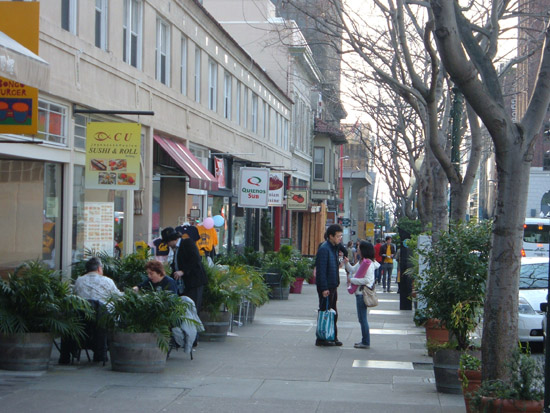
The SOSIP could let us transform the east branch of Shattuck Ave. and University Ave. east of Shattuck, in the same way that we have already transformed this sidewalk of Center St.
This page has described the part of the SOSIP that I am most excited about. For me, there is a strong symbolic resonance to replacing a modernist highrise with a fine-grained urban fabric of walkable streets. It is a rejection of modernist urbanism that reminds me of the demolition of the Pruitt-Igoe housing project, shown in the menu bar to the left. But it is even better, because the modernist urbanism is being replaced by an urban fabric created in a piecemeal way, like traditional urban fabrics.
And most of these changes seem very do-able politically. Most of them are small changes, and there is little or no opposition to them, but they add up to a dramatic change in what is now an automobile-dominated downtown.
This site created by Charles Siegel. Contact me at webpages@preservenet.com.
Photographs copyright 2010 by Charles Siegel